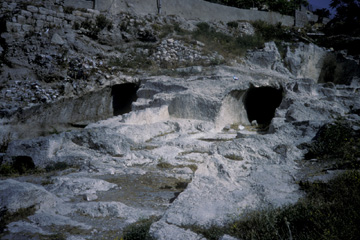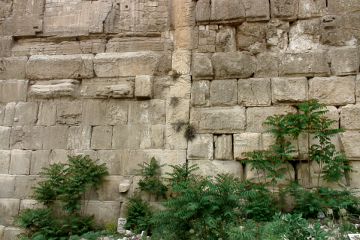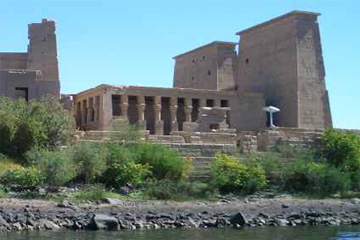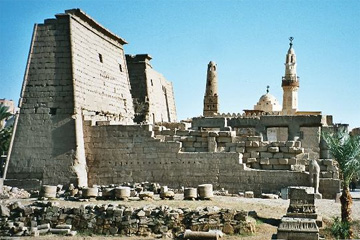Archaeology and the Bible
Kings and Chronicles - 1
Tombs of the Kings

| |
| These tunnels, exposed by Roman period quarrying, are believed to the the "Tombs of the Kings of Judah" referred to in the Bible. |
Kenyon's excavations at Jerusalem revealed that the whole of the summit of the ridge had been used as a quarry in Roman times when Aelia Capitolina was being built. Not only were the old buildings torn down and taken away for reuse, but the very bedrock itself was quarried away, so that nothing at all remains from the period. However the quarrying left exposed the two tunnels seen in the picture above. As they clearly were not water tunnels and seemed to serve no storage purpose, the excavators suggested that they are, in fact, the Royal Tombs of Jerusalem.
These tunnels are not signposted at all and I only stumbled across them by accident as I tried to take a short-cut from the Kidron Valley back up to the Old City. On a subsequent night-time visit I was met by a nervous soldier who pointed his Uzzi submachine gun uncomfortably close to my stomach and demanded to know why I was scrambling up the bare hillside. Unbeknown to me, the Israelis had built an observation post beside the tunnels to keep an eye on the obstreperous inhabitants of Silwan. The soldier refused to accept my explanation that I had come to see the tomb of David, insisting that it was on the opposite hill, but he eventually let me go - on the basis, I presume, that I was incurably insane.

| |
| This inscription, which mentions King Uzziah, the leper king, was found in the Russian Convent of St Mary Magdalene on the Mt of Olives. |
Curiously, we have the epitaph for one of these kings of Judah. Opposite Jerusalem on the slopes of the Mt of Olives are the gleaming golden onion domes of the Russian Convent of St Mary Magdalene. In 1931 Professor Sukenik of the Hebrew University visited the convent and was invited to view the sisters' little collection of antiquities. Among them he found a stone slab approximately 14" square on which was an inscription in archaic Aramaic letters.
Hither were brought
the bones of Uzziah
King of Judah.
Do not open.
The objects in the collection had been acquired by Archimandrite Antonin between 1865 and 1894, but if he left any record of where he found this particular object it disappeared, along with the handwritten catalogue of the museum, during the First World War. All we can say is that the script is typical of the time of Christ and indicates that the bones of Uzziah, which were buried separately from those of the other kings because of his leprosy, were moved to a new location, probably because of the expansion of the city in Herodian times.
Even without the inscription's statement that the royal bones were transferred to a new location ("hither were brought") the size of the stone would point in that direction, for it is the right size to form a cover for the coffin-sized tunnels known as kokhim in which people were buried in the time of Christ.
Solomon's Temple
No remains have yet been found from the fabulous temple built by King Solomon, nor are they likely to be found in the near future. Most archaeologists believe that the Temple Mount or Haram has been so altered by the various building operations that have taken place that any traces of Solomon's Temple will be fragmentary at best. In addition, the Waqf or Muslim administrative body which controls the Haram has shown by its actions that it is ignorant and bigotted and dogmatically opposed to the idea that the Jews might have inhabited Israel before 1948. The fact that this opinion is contrary to the facts of history does not trouble them at all.
Many years ago I read a book called The Arab Mind in which the author stated that Arabs appear to believe that the mere fact of asserting something gives it a form of reality. Over the years since then I have seen countless examples of this; perhaps the best example was during the Second Iraq War when Saddam Husein's spokesman stood in front of the world's press and stated categorically "There are no American tanks in Baghdad" while over his shoulders the cameras picked up American tanks rumbling down the street. The Iraqi spokesman was quite hurt that the Zionist-Western-Imperialist journalists wouldn't believe him and preferred the evidence of their own eyes!
The Waqf have asserted that the Jews did not have a temple on the Temple Mount, therefore the Jews did not have a temple there, no matter what documentary or archaeological evidence there might be to the contrary. They obviously are not going to give permission for archaeologists to look for something which they know is not there!
Nevertheless, outside the Haram, where the Waqf has no control and in a position where it cannot destroy the evidence without bringing the whole structure down around their ears, there is evidence for Solomon's temple.

| |
| The so-called "Straight Joint" is in the centre of the photograph. The difference in the masonry on either side can be clearly seen. |
During Kathleen Kenyon's excavations in Jerusalem in 1961-1967, the Jordanian Department of Antiquities cleared an accumulation of modern debris from around the south-east corner of the Temple Platform. This was by no means an extensive clearance, for Warren's digging in the area had demonstrated that the original ground level was a further 70' lower! Nevertheless, it exposed a portion of the wall which had been buried for a long time and in doing so uncovered a curious feature that Warren had noticed but whose significance had been ignored.
Stone walls, like brick walls, are not built by placing a stone or a brick directly on the one beneath. Rather the bricks in one course overlap those in the course below in a regular pattern. At the end of the wall you will find that the corner is made up of alternating layers of whole bricks and half-bricks to produce an even end to the wall.
Imagine now that you wish to build an extension to the wall, and that for whatever reasons you do not wish to knock out the half-bricks and continue the overlapping pattern. Instead you start afresh with alternating layers of whole and half-bricks and the result is that between the ends of the two walls you have a straight joint where the bricks do not interleave.
About thirty yards from the south-eastern corner of the Temple Platform there is precisely such a straight joint, approximately 40' high and, presumably continuing below ground level for another 70'. Furthermore, the stones on either side of this Straight Joint are different. Those to the south have low, smooth bosses surrounded by a finely chiselled margin; this is typical Roman or (in Palestine) Herodian stonework. To the north the stones have very prominent bosses surrounded by an even wider margin; this corresponds almost exactly with stonework of the Persian period in other sites such as Sidon and Byblos.
However the east wall of the Haram is a hotchpotch of different masonry styles. High in the wall are the small stones typical of the Islamic period, but as one walks to the north the stones lower down are typical of what is known as "Israelite" - prominent but roughly cut bosses surrounded by wide but irregular margins.
Kenyon's opinion is that the thirty yards of Herodian masonry represent the extension to the Temple Platform described by Josephus, built by Herod to accommodate the extra porticoes he erected around the temple. Inside this extension are the vaults known as "Solomon's Stables", which again are a typical Roman architectural feature.
The Persian period stonework at the old corner, site of the Straight Joint, is Zerubabel's reconstruction of the temple after the Exile, but the Israelite stonework visible in places is that of King Solomon. In other words, the wall of the Haram bears witness to a monumental Israelite construction in the position that the Bible records for Solomon's Temple. Thus although there may be uncertainty about exactly where on the Temple Platform the temple building stood, the fact that it was there is beyond doubt.
The Architecture of the Temple
People have speculated widely about the shape of Solomon's temple. I have even seen a large Victorian book whose author earnestly contended - backed up by magnificently detailed drawings - that the temple was an extra-large gothic cathedral! Most scholars these days assume that it was based on, or at least influenced by, Phoenician models and look to the temples of Byblos to illustrate what Solomon's temple looked like.
Certainly there were strong ties between Solomon and his Phoenician neighbours. King Hiram of Tyre provided cedar logs for Solomon's building projects and Phoenician stone masons helped to train Israelite workmen to cut the stone for the temple. Another Hiram, son of a Phoenician father and Israelite mother, was Solomon's metallurgist, casting all sorts of bronze equipment and furniture for the temple. However none of this tells us that Solomon used Phoenician architects or Phoenician models for the temple.

| |
| This diagram shows the relative heights and lengths of the three elements of the temple of Solomon. |
It is the measurements of the temple which give us a possible clue to its appearance. The innermost room, the Holy of Holies, was a perfect cube, 20 x 20 x 20 cubits. The outer room, the Holy Place, was 40 x 30 x 20 cubits - in other words, it was the same width as the inner room, twice as long and one and a half times as high. However in front of these two rooms was another chamber described in the Bible as "the porch" and whose measurements are given in 2 Chronicles 3:4. This astonishing room was 20 x 20 x 120 cubits!
Most scholars who have read this and considered its architectural implications quickly conclude that there is an error in the text. In plain language, the porch was 30' long, 30' broad, and 180' high! Such a building would be highly unstable and even if the techology of the time could build it, the first strong wind from the desert would topple it over! They conclude, therefore, that the height of the porch must have been 20 cubits and the numeral for "100" was added in by mistake or in an endeavour to make the temple seem more fabulous than it really was.

| |
| In this picture of the temples at Philae, notice how the pylon towers over the inner part of the temple. |
However if we remember that the measurements given in the Bible are the interior dimensions of the various chambers, we may be able to suggest a solution. From the time of the Old Kingdom onwards, Egyptian temples had been built with massive stone structures in front of them to which we give the Greek name "pylon". The shape of these pylons resembled the hieroglyph akhet, meaning "horizon", which represented two hills betwen which the sun rose. As in the photographs here, the pylon was always higher than the temple behind it and usually considerably higher (though never four times the height!)

| |
| The older temple of Luxor also has pylons which are double the height of the temple buildings behind them. |
In keeping with the idea of two hills with the rising sun between them, the passageway between the pylons was roofed about half-way up and there would be doors level with the inner wall of the pylon, so that the passageway might well be termed a "porch". However Solomon may have wished to make a difference between the Egyptian original and his own copy and put the roof at the top of the pylons, in which case you would indeed have a chamber that was 20 x 20 x 120!
Another parallel with the Egyptian temples is to be found in the twin bronze pillars, Jachin and Boaz, which stood in front of the temple. Some archaeologists have tried to compare them with the multitude of small standing stones in front of the Obelisk Temple at Byblos; others have seen a parallel with the standing stones in front of the House of Baal Berith at Shechem. In my opinion a better model is to be found in the pair of obelisks which usually stood in front of the pylons of Egyptian temples.
In other words, the temple of Solomon is better explained as an Egyptian style temple than as any of the other styles of which we know in the Middle East. It was not a slavish copy, but the similarities are clear.
The only question is whether such a huge piece of stonework could be built. The answer is that technically there is no reason why not. The Egyptians were building such things and had been for many centuries; the limestone of Palestine was as strong and as easily worked as the stone of Egypt, and there is no reason why Egyptian architects and workmen could not have travelled between the two countries.
That, however, is not the same as saying that it actually happened. The Bible makes no mention of Egyptian craftsmen and although arguments from silence can hardly be conclusive, it is a significant point. Certainly such a monumental building would be unparalleled in the whole of Palestine and Phoenicia - but that is rather the point about Solomon's temple: it was without parallel!
by its actions I refer, of course, to the recent building of an underground annex to the al-Aqsa mosque. The Waqf cleared tons of material from the Temple Mount and refused to allow any archaeological investigation before they set the digging machinery to work. If they were suspicious of Jewish archaeologists - and with the claims made by some Jewish archaeologists I wouldn't blame them - they could have called in archaeologists from Jordan or elsewhere.
As I note in the main part of the chapter, it is not that they do not know about archaeology, it was that they are afraid of what the archaeologists might find. Horror of horrors, they might even find that there was indeed a Jewish temple on the Temple Mount!
The Waqf claims that if they admitted that the Jewish temple stood in the area of the Haram it would somehow strengthen Jewish demands to rebuild the temple. This is nonsense. Jews know, as does any rational person, that the Jewish temple stood on the Temple Platform; the documentary evidence is clear on the point. Finding some stones from the Solomonic temple would not affect certainty about the site of the temple. Return
20 cubits This is not just a modern critical fancy. Some manuscripts of the LXX give the measurement as 20 cubits, as does the Syriac version of the Old Testament.
It should be pointed out that the largest pylon in Egypt, that of Pharaoh Taharqa of the Twenth-Fifth Dynasty at Karnak, is 131' high, 371' wide and 49' thick at the base. Here we have a structure which is almost as tall and only 30' thick. From the architectural point of view it would certainly be very much easier if the figure of 20 cubits was correct!
There is, however, an important reason for thinking that 120 cubits might be the right figure after all. The Holy of Holies was a perfect cube, as was the Holy of Holies in the Tabernacle before it; Solomon altered the proportions of the Holy Place by making it 30 cubits high and therefore unlike the original Holy Place which consisted of two cubes side by side, but he did not touch the proportions of the Most Holy Place. Clearly these proportionss were considered to be significant.
If the "porch" was only 20 cubits high, then it too would be a perfect cube and it seems to me unlikely that the proportions and dimensions of the most sacred structure, closed to all except the high priest and him only once a year, would be mirrored in the porch which was open to the priesthood in general as well as being exposed to every bird or swirl of dust that came along. Return





